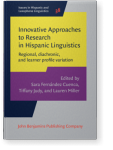Chapter 5
The emergence of sound change
in two varieties of Spanish
A usage-based analysis of variable trill /r/ production in
Caracas, Venezuela, and Caguas, Puerto Rico
We examine social and linguistic factors,
including lexical frequency, that influence variable production of
the alveolar rhotic trill in Caracas, Venezuela, and the region
surrounding Caguas, Puerto Rico. Two categories of rhotic
productions are established: non-innovative trills with two or more
occlusions and innovative reduced ones with fewer than two
occlusions and possible frication. Phonetic context, rhotic
duration, and lexical frequency conditioned trill production in both
varieties; mixed-effect logistic regressions showed that shorter
duration and high frequency tokens predicted use of innovative
variants in both varieties, while low vowels also did so in Caracas.
This suggests that Caracas and Caguas are experiencing variation
reflective of the early stages of a linguistic change, with
linguistic factors conditioning reduced variants.
Article outline
- 1.Introduction
- 2.Previous literature
- 2.1A phonetic description of trill production
- 2.2A sociolinguistic description of trill production
- 2.3Research questions
- 3.Methodology
- 3.1The Caracas corpus
- 3.2The Caguas area corpus
- 3.3Acoustic analysis and the dependent variable
- 3.4Independent variables
- 4.Results
- 4.1Logistic regression results
- 5.Discussion
- 6.Concluding remarks
-
Notes
-
References
